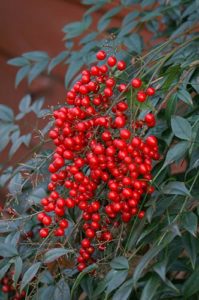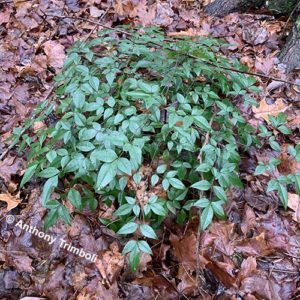By: Anthony Trimboli
Nandina (Nandina domestica), also commonly called heavenly bamboo, is an exotic ornamental shrub that is native to India, China, and Japan. Although not an actual bamboo, Nandina does have a cane-like growth pattern and will spread from root suckers. The dark, evergreen foliage and persistent bright red berries, coupled with the near indestructability of the plant has made Nandina one of the most commonly planted ornamental shrubs in the eastern United States.

The Problems with Nandina / Heavenly Bamboo
The hardiness and all-season visual interest of Nandina are excellent attributes for a landscape plant, but in the case of Nandina they come with a price. The ability of Nandina to survive in a wide range of soil types, moisture levels, various levels of shade, and the fact that it is impervious to most herbivorous mammals also makes Nandina a perfect plant for establishing itself where it does not belong. While spreading by root suckers will not allow a Nandina bush to escape from a home landscape, the brilliant red berries Nandina produces do give it the ability to venture into native ecosystems.
Many species of common songbirds such as American robins, cedar waxwings, northern mockingbirds, and eastern bluebirds are known to eat Nandina berries. The problem with this is twofold. First, the birds most likely will deposit the seeds contained within the berries in a remote location when they defecate, thus starting a new colony of Nandina. Being nearly browse-proof, these new Nandina patches are free to spread by suckers, and of course produce berries that will be eaten by birds and spread to more locations.
The second problem with birds eating Nandina berries is they can be poisoned by them. The foliage and berries both contain cyanide compounds, and if the berries are eaten in enough quantity, have been known to kill songbirds. Even if the birds do not die outright from the toxins, the effects of them can cause incoordination and seizures which could lead to depredation. The cyanides in Nandina are also toxic to humans, domestic pets, and livestock, although no human fatalities have ever been recorded.

How to Remove Nandina / Heavenly Bamboo
Removing Nandina from the home landscape can be as simple as digging it up, making sure to get as much of the root mass as possible. This normally works best with newer plantings that have not had several years to produce suckers. If the shrub is older, has expansive suckers, or cannot be removed by digging for some reason the application of herbicide will be required. Contact your local extension agent for recommendations on proper herbicides and treatments for eliminating Nandina.
Replacements for Nandina / Heavenly Bamboo
There are many native alternatives for Nandina. Winterberry (Ilex verticillata) is a native holly that produces brilliant red berries that persist into winter and are relished by birds. Inkberry (Ilex glabra) is another native holly that produces multitudes of blue-black berries. American beauty berry (Callicarpa americana), is a very attractive shrub that has pleasing bright green foliage and bears small clusters of white to pink flowers along its stems in summer, and is covered with clusters of pearlescent lavender colored berries in winter. An added bonus is all three of these plants are also loved by pollinators! These are just a few examples of native plants that can fill the same landscape niche as Nandina, the choices are vast and limited only by your landscape goals and personal taste.
Please tell your friends about Backyard Ecology.
(Social media sharing buttons can be found below the footer.)

Backyard Ecology: Exploring Nature in Your Backyard
Nature isn’t just “out there.” It’s all around us, including right outside our doors. Hi, my name is Shannon Trimboli, and I am the host of Backyard Ecology. I live in southcentral Kentucky and am a wildlife biologist, educator, author, beekeeper, and owner of a nursery specializing in plants for pollinators and wildlife conservation. I invite you to join me as we ignite our curiosity and natural wonder, explore our yards and communities, and improve our local pollinator and wildlife habitat. Learn more or subscribe to my email list at www.backyardecology.net.

Leave a Reply